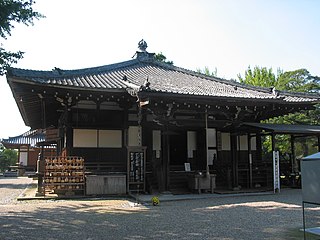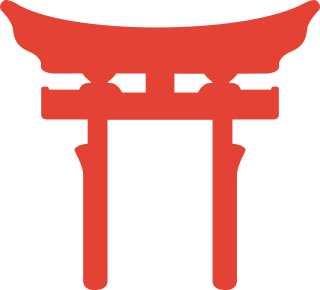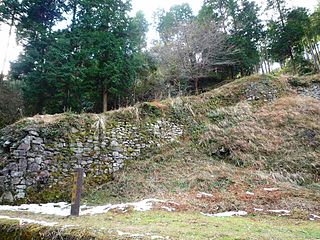 W
WThe Asuka period was a period in the history of Japan lasting from 538 to 710, although its beginning could be said to overlap with the preceding Kofun period. The Yamato polity evolved greatly during the Asuka period, which is named after the Asuka region, about 25 km (16 mi) south of the modern city of Nara.
 W
WChūgū-ji (中宮寺) is a temple in Nara Prefecture, Japan, that was founded as a nunnery in the seventh century by Shōtoku Taishi. Located immediately to the northeast of Hōryū-ji, its statue of Miroku and Tenjukoku mandala are National Treasures.
 W
WDaian-ji (大安寺) was founded during the Asuka period and is one of the Seven Great Temples of Nara, Japan.
 W
WFujinoki tomb is a tumulus, known as a kofun in Japanese, located in Ikaruga, Nara Prefecture, Japan. It is estimated to date from the later half of the sixth century or the late seventh century. The burial mound is about 40 or 48 metres in diameter, nine metres in height, and the stone chamber the mound covers is sixteen metres in length. Excavation began in 1985. The tomb yielded gilt-bronze ornaments, horse trappings, and a stone coffin.
 W
WFujiwara-kyō (藤原京) was the Imperial capital of Japan for sixteen years, between 694 and 710. It was located in Yamato Province, having been moved from nearby Asuka. However, the name Fujiwara-kyō was never used in the Nihon Shoki. During those times it was recorded as Aramashi-kyō (新益京).
 W
WGokishichidō was the name for ancient administrative units organized in Japan during the Asuka period, as part of a legal and governmental system borrowed from the Chinese. Though these units did not survive as administrative structures beyond the Muromachi period (1336–1573), they did remain important geographical entities until the 19th century. The Gokishichidō consisted of five provinces in the Kinai (畿内) or capital region, plus seven dō (道) or circuits, each of which contained provinces of its own.
 W
WThe Hachimanbayashi Kanga ruins is an archaeological site containing of the ruins of an Asuka period jōsaku-style Japanese castle located in what is now the Shimazaki neighborhood of the city of Nagaoka, Niigata in the Hokuriku region of Japan. The site was designated a National Historic Site of Japan in 1995.
 W
WThe Ise Grand Shrine , located in Ise, Mie Prefecture of Japan, is a Shinto shrine dedicated to the sun goddess Amaterasu. Officially known simply as Jingū (神宮), Ise Jingū is a shrine complex composed of many Shinto shrines centered on two main shrines, Naikū (内宮) and Gekū (外宮).
 W
WJōgū Shōtoku Hōō Teisetsu (上宮聖徳法王帝説), also read as Jōgū Shōtoku Hōō Taisetsu, is a biography of Shōtoku Taishi. It is one scroll in length and is a National Treasure of Japan.
 W
WKamiyodo Haiji (上淀廃寺) is a ruined Buddhist temple and national Historic Site in Yonago, Tottori Prefecture, Japan. Excavations between 1991 and 1993 uncovered temple buildings of the late Asuka period. The complex, which has an unusual plan, appears to have been destroyed by fire during the tenth or eleventh century. From the site of the kondō, hundreds of fragments of early Buddhist wall painting have been recovered. These were at the time identified as the earliest in Japan, alongside the wall paintings of the Hōryū-ji kondō. The paintings show a considerable sophistication of decoration despite the remoteness of the site, far from the political centre in the Yamato plain.
 W
WKawara-dera (川原寺) was a Buddhist temple established during the Asuka period in Asuka, Nara Prefecture, Japan. Excavations have revealed a large-scale complex which included two kondō, a pagoda, extensive priests' quarters, and roof tiles that are "among the most beautiful ever made in Japan". The area has been designated a Historic Site and forms part of a grouping of sites submitted in 2007 for future inscription on the UNESCO World Heritage List: Asuka-Fujiwara: Archaeological sites of Japan’s Ancient Capitals and Related Properties. Related artefacts are displayed at the Asuka Historical Museum.
 W
WThe Kitano temple ruins is an archaeological site with the ruins of an Asuka period Buddhist temple located in what is now the city of Okazaki, Aichi, Japan. The actual name of the temple is unknown, and no structures of the original temple exists, but the temple grounds were designated as a National Historic Site by the Japanese government in 1929.
 W
WKōfuku-ji is a Buddhist temple that was once one of the powerful Seven Great Temples in the city of Nara, Japan. The temple is the national headquarters of the Hossō school.
 W
WKofun are megalithic tombs or tumuli in Northeast Asia. Kofuns were constructed between the early 3rd century and the early 7th century AD. The term is the origin of the name of the Kofun period, which indicates the middle 3rd century to early–middle 6th century. Many Kofun have distinctive keyhole-shaped mounds, which are unique to ancient Japan. The Mozu-Furuichi kofungun or tumulus clusters were inscribed on the UNESCO World Heritage List in 2019, while Ishibutai Kofun is one of a number in Asuka-Fujiwara residing on the Tentative List.
 W
WKojiki , also sometimes read as Furukotofumi or Furukotobumi, is an early Japanese chronicle of myths, legends, songs, genealogies, oral traditions, and semi-historical accounts down to 641 concerning the origin of the Japanese archipelago, the kami (神), and the Japanese imperial line. It is claimed in its preface to have been composed by Ō no Yasumaro at the request of Empress Genmei in the early 8th century (711–712), and thus is usually considered to be the oldest extant literary work in Japan. The myths contained in the Kojiki as well as the Nihon Shoki (日本書紀) are part of the inspiration behind many practices. Later, the myths were re-appropriated for Shinto practices such as the misogi purification ritual.
 W
WOver the course of the Yamato period, in the early centuries of the establishment of a Japanese state, a great number of Korean-style fortresses were constructed in Japan. Old fortresses dating to the 8th century and earlier can be found all over western Japan. Many of these sites have been identified with fortresses whose construction, repair, and destruction are described in detail in ancient chronicles such as Nihon Shoki and Shoku Nihongi. According to some interpretations of these texts, these fortresses were built under the guidance of, and at the orders of, various members of the Korean nobility or royalty.
 W
WKosugimaruyama Site is an archaeological site with the ruins of a late Asuka period pottery production site located in what is now the city of Imizu, Toyama Prefecture in the Hokuriku region of Japan. It has been protected by the central government as a National Historic Site since 1990.
 W
WMan'yōgana is an ancient writing system that employs Chinese characters to represent the Japanese language, and was the first known kana system to be developed as a means to represent the Japanese language phonetically. The date of the earliest usage of this type of kana is not clear, but it was in use since at least the mid-seventh century. The name "man'yōgana" derives from the Man'yōshū, a Japanese poetry anthology from the Nara period written with man'yōgana.
 W
WMii-dera (三井寺,御井寺), formally called Onjō-ji (園城寺), is a Buddhist temple in Japan located at the foot of Mount Hiei, in the city of Ōtsu in Shiga Prefecture. It is only a short distance from both Kyoto, and Lake Biwa, Japan's largest lake. The head temple of the Jimon sect of Tendai, it is something of a sister temple to Enryaku-ji, at the top of the mountain, and is one of the four largest temples in Japan. Altogether, there are 40 named buildings in the Mii-dera complex.
 W
WOkozu Salt Works is the location of a salt production site located in what is now part of the city of Obama, Fukui in the Hokuriku region of Japan. The site was designated a National Historic Site of Japan in 1979.
 W
WŌno Castle is a ruined castle located on Mount Shioji in the northern part of Dazaifu city in Fukuoka Prefecture, Japan.
 W
WSannō temple ruins is an archaeological site with the ruins of a Buddhist temple located in what is now the Sōja neighborhood of city of Maebashi, Gunma, Japan. The temple no longer exists, but the temple grounds were designated as a National Historic Site by the Japanese government in 1928, with the designated area extended in 2008.
 W
WShimotsuke Yakushi-ji (下野薬師寺) was a Buddhist temple located in what is now the city of Shimotsuke, Tochigi Prefecture, in northern Kantō region of Japan. It is one of the earliest Buddhist temples in western Japan, having been founded in the Asuka period. The temple is now a ruin and an archaeological site and has been designated by the national government as a National Historic Site since 1921.
 W
WShōge temple ruins , is an archaeological site with the ruins of a late Hakuhō to early Heian period Buddhist temple located in what is now the city of Ena, Gifu, Japan. The temple no longer exists, but the temple grounds were designated as a National Historic Site by the Japanese government in 2001.
 W
WSuematsu temple ruins (末松廃寺跡) is an archaeological site with the ruins of a Hakuho period Buddhist temple located in what is now the city of Nonoichi, Ishikawa, Japan. The temple no longer exists, but the temple grounds were designated as a National Historic Site by the Japanese government in 1939.
 W
WThe Tachibana Shrine , also referred to as the Lady Tachibana Shrine, is a miniature shrine owned by the Hōryū-ji temple complex of Nara Prefecture, Japan. Its precise date of construction is unknown, but it is thought to have been created a little later than its counterpart the Tamamushi Shrine. The sculptures inside are dated to the years around 710 and have been designated a National Treasure.
 W
WThe Tamamushi Shrine is a miniature shrine owned by the Hōryū-ji temple complex of Nara, Japan. Its date of construction is unknown, but estimated to be around the middle of the seventh century. Decorated with rare examples of Asuka-period paintings, it provides important clues to the architecture of the time and has been designated a National Treasure.
 W
WYamanoue Stele is an Asuka period stele discovered in the Yamana neighborhood of the city of Takasaki, Gunma Prefecture, in the northern Kantō region of Japan. The stele was designated a National Historic Site of Japan in 1921, and was raised in status to that of a Special National Historic Site in 1954. It is associated with the adjacent Yamanoue Kofun (山ノ上古墳), a kofun burial mound, which is also covered under the Special Historical Site designation. As one of the "Three Stelae of Kōzuke", the Yamanoue Stele was submitted by Japan for inclusion into the UNESCO Memory of the World Programme in 2017 The inscription on the Yamanoue Stele is the oldest example of writing in Chinese characters according to Japanese grammar.
 W
WThe Yamato period is the period of Japanese history when the Japanese Imperial court ruled from modern-day Nara Prefecture, then known as Yamato Province.